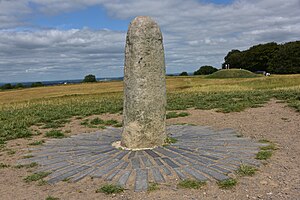Hill of Tara

The Hill of Tara (Irish: Teamhair or Cnoc na Teamhrach) is a hill and ancient ceremonial and burial site near Skryne in County Meath, Ireland. Tradition identifies the hill as the inauguration place and seat of the High Kings of Ireland; it also appears in Irish mythology. Tara consists of numerous monuments and earthworks—dating from the Neolithic to the Iron Age—including a passage tomb (the "Mound of the Hostages"), burial mounds, round enclosures, a standing stone (believed to be the Lia Fáil or "Stone of Destiny"), and a ceremonial avenue. There is also a church and graveyard on the hill. Tara forms part of a larger ancient landscape and Tara itself is a protected national monument under the care of the Office of Public Works, an agency of the Irish Government.
The name Tara is an anglicization of the Irish name Teamhair or Cnoc na Teamhrach ('hill of Tara'). It is also known as Teamhair na Rí ('Tara of the kings'), and formerly also Liathdruim ('the grey ridge').The Old Irish form is Temair. It is believed this comes from Proto-Celtic *Temris and means a 'sanctuary' or 'sacred space' cut off for ceremony, cognate with the Greek temenos (τέμενος) and Latin templum. Another suggestion is that it means "a height with a view".
The Hill of Tara (Irish: Teamhair or Cnoc na Teamhrach) is a hill and ancient ceremonial and burial site near Skryne in County Meath, Ireland. Tradition identifies the hill as the inauguration place and seat of the High Kings of Ireland; it also appears in Irish mythology. Tara consists of numerous monuments and earthworks—dating from the Neolithic to the Iron Age—including a passage tomb (the "Mound of the Hostages"), burial mounds, round enclosures, a standing stone (believed to be the Lia Fáil or "Stone of Destiny"), and a ceremonial avenue. There is also a church and graveyard on the hill. Tara forms part of a larger ancient landscape and Tara itself is a protected national monument under the care of the Office of Public Works, an agency of the Irish Government. [2]
Name
The name Tara is an anglicization of the Irish name Teamhair or Cnoc na Teamhrach ('hill of Tara'). It is also known as Teamhair na Rí ('Tara of the kings'), and formerly also Liathdruim ('the grey ridge'). The Old Irish form is Temair. It is believed this comes from Proto-Celtic *Temris and means a 'sanctuary' or 'sacred space' cut off for ceremony, cognate with the Greek temenos (τέμενος) and Latin templum. Another suggestion is that it means "a height with a view".
Saint Patrick's Church
A church, called Saint Patrick's, is on the eastern side of the hilltop. The "Rath of the Synods" has been partly destroyed by its churchyard. The modern church was built in 1822–23 on the site of an earlier one.
Significance
By the beginning of Ireland's historical period, Tara had become the seat of a sacral kingship. Historian Dáibhí Ó Cróinín writes that Tara "possessed an aura that seemed to set it above" the other royal seats. It is recorded as the seat of the High King of Ireland (Ard Rí) and is "central to most of the great drama in early Irish literature". Various medieval king lists traced a line of High Kings far into the past.
Irish legend says that the Lia Fáil (Stone of Destiny) at Tara was brought to Ireland by the divine Tuatha Dé Danann, and that it would cry out under the foot of the true king. Medb Lethderg was the sovereignty goddess of Tara. The cult of the sacral kingship of Tara is reflected in the legends of High King Conaire Mór, while another legendary High King, Cormac mac Airt, is presented as the ideal king.The reign of Diarmait mac Cerbaill, a historical king of Tara in the sixth century, was seen as particularly important by medieval writers. Although he was probably pagan, he was also influenced by Christian leaders and "stood chronologically between two worlds, the ancient pagan one and the new Christian one".
The Five Roads of Tara
According to legend, five ancient roads or slighe meet at Tara, linking it with all the provinces of Ireland. The earliest reference to the five roads of Tara was in the tale Togail Bruidne Da Derga (The Destruction of Da Derga's Hall).
The five roads are said to be:
- Slighe Assail, which went west towards Lough Owel, then to Rathcroghan.
- Slighe Midluachra, which went to Slane, then to Navan Fort, ending at Dunseverick.
- Slighe Cualann, which went through Dublin and through the old district of Cualann towards Waterford.
- Slighe Dala, which went towards and through Ossory.
- Slighe Mhór ('Great Highway'), which roughly followed the Esker Riada to County Galway.

